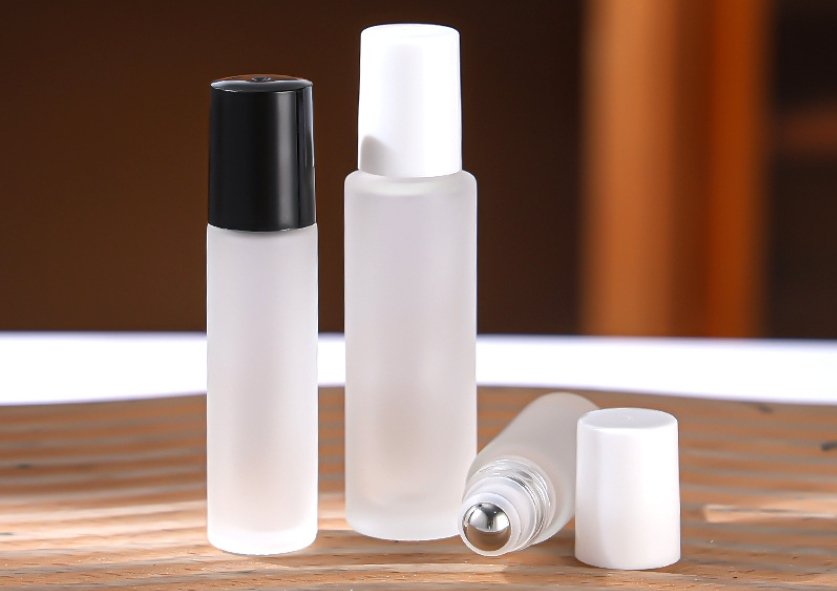Introduction
Frosted glass cosmetic containers—classic, luxury, and always in fashion. But to be honest, not every frosted glass is created equal. Some brands end up with jars that look cheap, scratch easily, or even worse, arrive broken because of unproper manufacturing.

At our Guangzhou factory (with 10+ years of experience in glass frosting), we’ve seen it all—the good, the poor, and the “Why did this even pass Quality Inspection Team?” moments. This guide will walk you through the key processes, common mistakes, and insider tips to ensure your custom frosted glass jars is flawless.
- What Exactly is Frosted Glass?
Frosted glass (or “matte glass”) is created by etching the surface to create a soft, diffused look. Unlike clear glass, it offers:
✔ Premium feel – No fingerprints, no glare, just pure elegance.
✔ Better grip – Less slippery than glossy glass (great for foundations and serums).
✔ Branding flexibility – Can be combined with screen printing, UV coating, or embossing.
But here’s the point: Not all frosting techniques are equal. Some methods create a durable finish, while others wear off after just a few months.
- The 3 Main Frosting Methods (And Which One You Should Choose)
Method How It Works Pros Cons Best For
Sandblasting High-pressure sand particles blast the glass Durable, deep matte finish Expensive, slower production High-end skincare brands
Acid Etching Chemical bath dissolves the glass surface Smooth, even finish Environmental concerns Medium-budget brands
Spray Coating A frosted-effect coating is sprayed on Cheap, fast turnaround Less durable, can peel off Short-run promotions
💡 Our Take?
Sandblasting is the gold standard (we use it for 80% of our customers).
Acid etching works but requires strict waste management (we’ve had a few “oops, the acid was too strong” moments).
Spray coating? Honestly, it’s a bit of a gamble—great for temporary packaging but not long-term use.
- The Manufacturing Process: Step by Step
Step 1: Glass Selection
Not all glass is frost-friendly. Soda-lime glass (most common for cosmetics) works well, but:
Too thin? Risk of breakage during sandblasting.
Too thick? Increases shipping costs.
We recommend 2.5mm to 3mm thickness for the best balance.
Step 2: Frosting (Sandblasting in Action)
The glass is masked (to protect logos or clear sections).
Aluminum oxide grit is blasted at controlled pressure (too high = cracks, too low = patchy finish).
Fun fact: We once blasted a batch too aggressively and ended up with *“accidental vintage distressed glass”—not what the client wanted!
Step 3: Quality Checks
Visual inspection (no uneven spots, cracks, or rough edges).
Scratch test (if frosting rubs off too easily, back to the blaster).
Water resistance test (because nobody wants a jar that stains after one use).
Step 4: Custom Finishing (Optional but Fancy)
Metallic edge painting (rose gold, anyone?).
Embossed logos (adds a tactile premium touch).
Interior coating (for extra protection against acids in serums).
- Common Quality Issues (And How to Avoid Them)
We’ve made mistakes so you don’t have to:
Problem Why It Happens How We Fixed It
Uneven frosting Inconsistent blasting pressure Now use automated pressure control
Scratches too easily Low-quality glass or weak frosting Switched to higher-grade materials
Jars breaking in transit Poor packaging + thin glass Added double-wall cartons
Personal opinion: Frosted glass isn’t perfect—it can scratch over time. But with the right process, it lasts way longer than cheap spray coatings.
- How to Choose the Right Supplier
If you’re sourcing from China (like many brands do), ask:
✅ “Can I see your QC reports from the last 6 months?”
✅ “Do you offer scratch-resistance testing?”
✅ “What’s your defect rate?” (Ours is <2%, but some factories hide the real numbers.)
🚨 Red Flags:
A supplier who says, “All our glass is the same quality.” (Nope, it’s not.)
No samples for testing.
Super low prices (you’ll pay in quality headaches later).
- Final Thoughts: Is Frosted Glass Right for You?
✔ Yes, if you want a luxury look without fingerprints.
✔ Yes, if durability matters (go for sandblasting).
❌ No, if you need ultra-cheap packaging (frosted glass costs 20-30% more than clear glass).
Our Guangzhou factory has been refining this process for a decade—we know where the pitfalls are. Want a free sample batch to test? [Contact us–joychen@aimoqipackaging.com] and let’s make your dreamed jars a reality.
Got questions? Drop a comment or Email us.

